Security Fundamentals in AWS
🔎Overview
Security in AWS is a layered discipline - the OSI Model offers a clear way to think about where and how to apply security controls. Here’s the 7 Layers and the respective AWS Services.
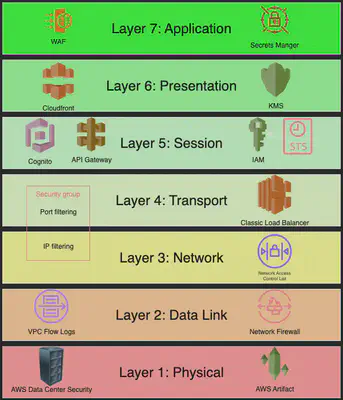
This cheatsheet maps the seven layers of the OSI model to AWS services that help implement defense-in-depth.
📱Layer 7: Application
Layer-7 is where user-facing applications operate (e.g., HTTP, HTTPS, DNS, SMTP). Security at this layer is critical because it directly interacts with users and is often the most targeted by attackers.
⚠️ Common Threats at Layer 7
| 🚨 Threat | 📝 Description |
|---|---|
| SQL Injection | Malicious SQL queries to manipulate or access databases. |
| Cross Site Scripting | Injecting malicious scripts into web pages viewed by other users. |
| Cross-Site Request Forgery(CSRF) | Tricks users into executing unwanted actions on a web app. |
| Code Injection | Exploiting vulnerabilities to run arbitrary code on the server. |
| API Abuse | Excessive or malformed API calls to disrupt or exploit services. |
| DDOS | Flooding application endpoints with high-volume traffic. |
| Broken Authentication | Exploiting weak session or credential handling mechanisms. |
| Sensitive Data Exposure | Insecure transmission or storage of personal or confidential data. |
🚨Distributed Denial of Service (DDOS Attack)

- Service becomes unavailable because it’s receiving too many requests (
Layer-4attacks)SYN Flood: send too many TCP connection requestsUDP Reflection: get other servers to send many big UDP requestsDNS floodattack: overwhelm the DNS so legitimate users can’t find the siteSlow Lorisattack: a lot of HTTP connections are opened and maintained
- Application level attacks (
Layer-7attacks):- Complex, Application Specific (spike in
POSTrequests to/login) - Cache Bursting💥: Overload the backend database by invalidating cache
- Complex, Application Specific (spike in
🧱AWS WAF
- Protects your web applications from common web exploits (
Layer 7)- Deploy on Application Load Balancer (
ALB) (localized rules) - Deploy on
API Gateway(rules running at the regional or edge-level) - Deploy on
CloudFront(rules globally on edge-locations) - Used to front other solutions:
CLB,EC2instances, custom origins,S3websites - Deploy on
AppSync(protect your GraphQL APIs)
- Deploy on Application Load Balancer (
WAFis not only forDDoSprotection- Define Web ACL (Web Access Control List):
- Rules can include IP addresses, HTTP headers, HTTP body, or URI strings
- Size constraints, Geo match
- Rate-based rules (to count occurrences of events)
- Rule Actions: Count | Allow | Block | CAPTCHA Challenge
- Library of over 190 ready-to-use managed rules
- Baseline Rule Groups – general protection from common threats
AWSManagedRulesCommonRuleSet,AWSManagedRulesAdminProtectionRuleSet, … - Use-Case Specific Rule Groups – protection for many AWS WAF use cases
AWSManagedRulesSQLiRuleSet,AWSManagedRulesWindowsRuleSet,AWSManagedRulesPHPRuleSet,AWSManagedRulesWordPressRuleSet, … - IP Reputation Rule Groups – block requests based on source (e.g. malicious IPs
AWSManagedRulesAmazonIpReputationList,AWSManagedRulesAnonymousIpList - Bot Control Managed Rule Group – block and manage requests from bots
AWSManagedRulesBotControlRuleSet
Solution Architecture - Enhance CloudFront Origin Security
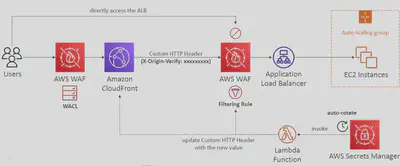
To ensure that only traffic routed through Amazon CloudFront reaches an Application Load Balancer (ALB) — and to block direct access from end-users — you can implement a layered security approach using AWS WAF and custom headers.
- First, apply a
WAFWeb ACL at the CloudFront level to filter client requests. - Then, configure
CloudFrontto inject a custom HTTP header (e.g.,X-Origin-Verify) with a secret value into each request. - On the
ALB, set up a WAF rule that only allows traffic containing this header, effectively blocking direct access. - For enhanced security, automate header rotation using AWS
Secrets Managerand aLambdafunction to periodically update both theCloudFrontheader and theALBWAF rule.
Solution Architecture - Bad Bot Protection

This solution uses AWS WAF, Amazon Kinesis Data Firehose, Amazon S3, and AWS Lambda to detect and block malicious bots automatically.
- A hidden trap endpoint acts as a honeypot to catch bots scanning the site.
- Incoming requests are inspected by AWS
WAF, which applies Bad Bot Protection rules and labels suspicious traffic. - Logs are streamed via
Kinesis Data Firehoseproviding buffering, scaling, transformation(convert JSON to Parquet), and reliable delivery into Amazon S3. - An AWS Lambda function parses WAF logs from S3, filters entries with bad-bot labels or trap endpoint hits, and extracts the Source IPs.
- These IPs are added then added back to a
WAFIP set for automated blocking for a configurable duration.
🕵️AWS Inspector

Amazon Inspector adds another layer of defense by performing vulnerability scans on EC2 instances, Containers, and Lambda functions against a database of known CVEs
- For
EC2instances:- Leveraging the AWS System Manager(
SSM) agent - Analyze against unintended network accessibility
- Analyze the running OS against known vulnerabilities
- Leveraging the AWS System Manager(
- For
ContainerImages push to AmazonECR:- Assessment of Container Images as they are pushed
- For
LambdaFunctions:- Identifies software vulnerabilities in function code and package dependencies
- Assessment of functions as they are deployed
- Reporting & integration with AWS
Security Hub - Send findings to Amazon
Event Bridge
💂AWS GuardDuty
Amazon GuardDuty serves as a threat detection engine, continuously analyzing AWS account activity, VPC Flow logs, and DNS queries for signs of compromised resources or malicious behavior.
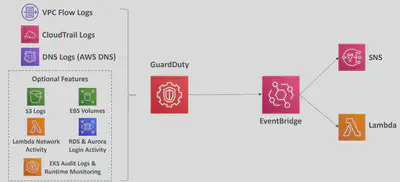
- Intelligent Threat discovery to protect your AWS Account
- Uses Machine Learning algorithms, anomaly detection, 3rd party data
- One click to enable (30 days trial), no need to install software
- Input data includes:
- CloudTrail
Events Logs– unusual API calls, unauthorized deployments - CloudTrail
Management Events– create VPC subnet, create trail, … - CloudTrail S3
Data Events– get object, list objects, delete object, … VPC Flow Logs– unusual internal traffic, unusual IP addressDNS Logs– compromised EC2 instances sending encoded data within DNS queries- Optional Features –
EKSAudit Logs,RDS&Aurora,EBS,Lambda,S3Data Events…
- CloudTrail

- Can setup
EventBridgerules to be notified in case of findings - EventBridge rules can target AWS
LambdaorSNS - Can protect against CryptoCurrency attacks (has a dedicated finding for it)
- AWS Organization member accounts can be designated to be a GuardDuty Delegated Administrator
- Have full permissions to enable and manage GuardDuty for all accounts in the Organization
- Can be done only using the Organization Management Account
🔗SSM ParameterStore
Secure storage for configuration and secrets
Optional Seamless Encryption using KMS
Serverless, scalable, durable, easy SDKVersion tracking of configurations / secrets
Configuration management using path &
IAMNotifications with Amazon
EventBridgeIntegration with
CloudFormation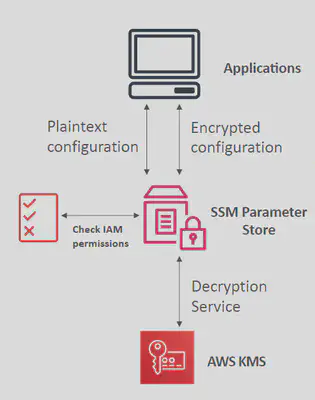
SSM Parameter Store Hierarchy:
- /my-department/
- my-app/
- dev/
- db-url
- db-password
- prod/
- db-url
- db-password
- dev/
- other-app/
- my-app/
- /other-department/
- /my-department/
Two parameter tiers available: Standard Vs Advanced
Characteristics Standard Advanced Total number of parameters allowed (per AWS account and Region) 10,000 100,000 Maximum size of a parameter value 4 KB 8 KB Parameter policies available No Yes Cost Free $0.05 per advanced parameter per month Here’s some examples of SSM Advanced Parameter Polcies

SSM Public Parameters
SSM public parameters are read-only, globally available parameters published by AWS under the /aws/service/ namespace. They’re designed to:
✅ Avoid hardcoding resource IDs (e.g., AMI IDs)
🔄 Auto-update when AWS releases new versions
🌍 Support multi-region deployments seamlessly
🔐 Enable secure referencing of secrets via SSM syntax They’re especially useful in CloudFormation, CDK, Terraform, and CI/CD pipelines where you want modular, future-proof infrastructure.
Here’s a list of common examples:
| Parameter Category | Example Full Parameter Path | Usage / Description |
|---|---|---|
| Amazon Linux | /aws/service/ami-amazon-linux-latest/amzn2-ami-hvm-x86_64-gp2 | Retrieves the AMI ID for the latest Amazon Linux 2 with HVM virtualization for an x86_64 architecture using a GP2 root volume. |
| Windows Server | /aws/service/ami-windows-latest/Windows_Server-2022-English-Full-Base | Gets the AMI ID for the base image of Microsoft Windows Server 2022 (English, Full installation). |
| ECS-Optimized | /aws/service/ecs/optimized-ami/amazon-linux-2/recommended | Fetches the recommended AMI ID for running Amazon ECS container instances on an Amazon Linux 2 base. |
| EKS-Optimized | /aws/service/eks/optimized-ami/1.30/amazon-linux-2/recommended | Provides the recommended AMI ID for an Amazon EKS worker node compatible with Kubernetes version 1.30 on Amazon Linux 2. |
| Deep Learning | /aws/service/deep-learning-amis/latest/ubuntu-22.04 | Finds the latest Deep Learning AMI based on Ubuntu 22.04, pre-packaged with popular machine learning frameworks. |
| RDS Custom | /aws/service/rds/optimized-ami/oracle-ee/19.21.0.0.ru-2023-10.rur-2023-10.r1/x86_64/1 | Stores the AMI ID for a specific version of Amazon RDS Custom for Oracle Enterprise Edition, ensuring a compatible OS environment. |
🗄️Secrets Manager

- Meant for storing secrets (e.g., passwords, API keys)
- Capability to force rotation of secrets every X days
- Automate generation of secrets on rotation (uses
Lambda) - Natively supports Amazon
RDS(all supported DB engines), Redshift, DocumentDB - Support other databases and services (custom Lambda function)
- Automate generation of secrets on rotation (uses
- Control access to secrets using
Resource-basedPolicy - Integration with other AWS services to natively, pull secrets from
Secrets Manager: CloudFormation, CodeBuild, ECS, EMR, Fargate, EKS, Parameter Store…
Secrets Manager – with CloudFormation

Secrets Manager – Cross Account
Account B must be allowed to
decryptthe secret in Account A.KMS
Key Policyin Account A:{ "Sid": "AllowAccountBToDecrypt", "Effect": "Allow", "Principal": { "AWS": "arn:aws:iam::<AccountB-ID>:role/<RoleName>" }, "Action": [ "kms:Decrypt", "kms:DescribeKey" ], "Resource": "*" }Attach a
Resource-BasedPolicy to the Secret:{ "Version": "2012-10-17", "Statement": [ { "Sid": "AllowAccountBToAccessSecret", "Effect": "Allow", "Principal": { "AWS": "arn:aws:iam::<AccountB-ID>:root" }, "Action": [ "secretsmanager:GetSecretValue", "secretsmanager:DescribeSecret" ], "Resource": "*" } ] }
🆚Secrets Manager vs. SSM ParameterStore
- Automatic rotation of secrets with AWS Lambda
- Integration with RDS, Redshift, DocumentDB
- KMS encryption is mandatory
- Can integration with CloudFormation
- Simple API
- No secret rotation
- KMS encryption is optional
- Can integration with CloudFormation
- Can pull a Secrets Manager secret using the SSM Parameter Store API
🧬Layer 6: Presentation
The Presentation layer is responsible for translating, formatting, and securing data before it reaches the Application layer. In modern cloud environments, this often means ensuring data is encrypted both in transit🚇 and at rest💤 using trusted protocols and managed cryptographic services. Weaknesses at this layer can lead to data leakage, man-in-the-middle attacks, or violations of compliance requirements.
🔐Encryption
Encryption is a critical component of a defense-in-depth strategy, which is a security approach adopted by AWS with a series of defensive mechanisms designed so that if one security mechanism fails, there’s at least one more still operating.
There are 2 forms of encryption in practice:
Encryption in transit🚇:
- Data is encrypted before sending and decrypted after receiving
- SSL certificates help with encryption (HTTPS)
- Encryption in flight ensures no MITM can happen

Encryption at Rest💤:
Data is encrypted after being received by the server
Data is decrypted before being sent
It is stored in an encrypted form thanks to a key (usually a data key)
The encryption/decryption keys must be managed somewhere and the server must have access to it.
There are two main methods to encrypt data at rest:
- Client-Side Encryption: As the name implies this method encrypts your data at the client-side before it reaches backend servers or services. You have to supply encryption keys 🔑 to encrypt the data from the client-side. You can either manage these encryption keys yourself or use AWS
KMS(Key Management Service) to manage the encryption keys under your control. - AWS provides multiple client-side SDKs to make this process easy for you. E.g. AWS Encryption SDK, S3 Encryption Client, DynamoDB Encryption Client etc…

Server-Side Encryption: In Server-Side encryption, AWS encrypts the data on your behalf as soon as it is received by an AWS Service. Most of the AWS services support server-side encryption. E.g. S3, EBS, RDS, DynamoDB, Kinesis, etc…
All these services are integrated with AWS
KMSin order to encrypt the data.

- Client-Side Encryption: As the name implies this method encrypts your data at the client-side before it reaches backend servers or services. You have to supply encryption keys 🔑 to encrypt the data from the client-side. You can either manage these encryption keys yourself or use AWS
AWS Certificate Manager(ACM)
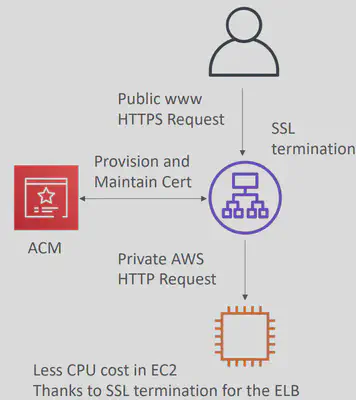
- To host public SSL certificates in AWS, you can:
- Buy your own and upload them using the CLI
- Have
ACMprovision and renew public SSL certificates for you (free of cost)
ACMloads SSL certificates on the following integrations:Load Balancers(including the ones created by EB)CloudFrontdistributions- APIs on
API Gateways
- ACM is a regional service
- To use with a global application (multiple
ALBfor example), you need to issue an SSL certificate in each region where you application is deployed. - You cannot copy certs across regions
- To use with a global application (multiple
🗝️KMS
AWS Key Management Store (KMS) is a managed service that enables you to easily encrypt your data.
AWS KMS provides a highly available key storage, management, and auditing solution for you to encrypt data within your own applications and control the encryption of stored data across AWS services.
KMS is used to fully manage the keys & their policies:
- 🆕Create
- 🔄Rotation policies
- ⏸️Disable
- ▶️Enable
- 🔎Able to audit key usage (using CloudTrail)
- 💶Pay for API call to KMS ($0.03 / 10000 calls)
KMS Key Types
- 🔐**KMS Keys**
- 🔧**Customer Managed Keys**
Full lifecycle control
Custom key policies
$1/month + usage
- 🔁**Symmetric Keys**
AES-256
Used for ```Encrypt/Decrypt```
- 📨**Data Keys**
Ephemeral symmetric keys
Used for local encryption of large data (Envelope Encryption)
- 📥**Imported Key Material**
Bring your own key (```BYOK```)
- 🏦**External Key Store (```XKS```)**
Key lives outside AWS
AWS KMS acts as proxy
- 🔀**Asymmetric Keys**
RSA or ECC key pairs
Used for ```Encrypt/Decrypt``` or ```Sign/Verify```
- 🌍**Multi-Region**
Symmetric and Asymmetric keys
Enables **cross-region** encryption/decryption
Same key material, separate resource IDs
- 🧰**Cloud HSM**
Symmetric and Asymmetric keys
AWS provsisioned **dedicated** hardware
- 🛠️**AWS Managed Keys**
Created and managed by AWS
Always 🔁**Symmetric Keys**
View Key Policy(ReadOnly) and audit in CloudTrail
Free
- 🏢**AWS Owned Keys**
Internal to AWS
Used for **default** encryption
Always 🔁**Symmetric Keys**
No access to find/editds Key Policy
FreeCustomer Managed Key (CMK) Types
🔁Symmetric (
AES-256keys)- Single encryption key that is used to
EncryptandDecrypt - AWS services that are integrated with KMS use
SymmetricCMKs - Necessary for
Envelopeencryption - You never get access to the unencrypted Key (must call KMS APIs to use)
- KMS can only help in encrypting up to 4KB of data per call. If data > 4 KB, then use
Data Keys. - To give access to KMS to someone:
- Make sure the Key Policy allows the user
- Make sure the IAM Policy allows the API calls
- Single encryption key that is used to
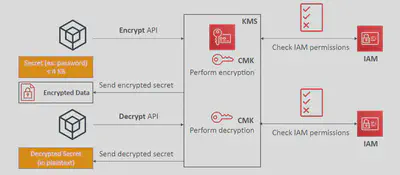
🔀Asymmetric (
RSA&ECCkey pairs)- Public (
Encrypt) and Private Key (Decrypt) pair - Used for
Encrypt/Decrypt, orSign/Verifyoperations Publickey is downloadable;Privatekey remains protected.- Anything encrypted with a
publickey can only be decrypted by the correspondingprivatekey. - 🧠Use cases:
- Encryption outside of AWS by users who can’t call the KMS API
- Public distribution of software packages (say
Docker) where end users needs to verify the authenticity.
- Public (
Key Considerations:
A key drawback to
asymmetriccryptography is the fact that you cannot encrypt large pieces of data. When you have a 2048-bit RSA key pair and encrypt something by using the cipher RSAES_OASEP_SHA_256, the largest amount of data that you can encrypt is 190 bytes.In contrast,
symmetricencryption ciphers that use a chained or counter-mode operation don’t have this limit, and they make it possible for you to encrypt data in the tens-of-gigabytes.KMS keys (symmetric or asymmetric) encryption limit: 4KB (4096 bytes) per Encrypt API call - this is a
KMSservice-imposed limit, not acryptographicone.So typically the client would use a hybrid cryptosystem i.e. the client encrypts its large payload by using a symmetric key, then encrypts that symmetric key by using the downloaded RSA public key. End clients then transmit only encrypted data and encrypted key across insecure channels, maintaining privacy of the payload data.
KMS Asymmetric Keys Encrypt-Decrypt (Offline) flow
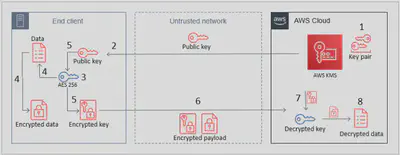
- Create an
RSAkey pair in AWS KMS. - Download or pre-install the AWS KMS
public keyto an end-client device. - Generate an AES 256-bit (
symmetric) key on an end client. - Encrypt a large payload of data on the end client by using the AES 256-bit key.
- Encrypt the AES 256-bit key with the AWS KMS
public key. - Transfer the encrypted payload and key.
- Decrypt the AES 256-bit key by using RSA
private keyin KMS. - Decrypt the payload data by using the now decrypted AES 256-bit key.
KMS Asymmetric Keys Sign-Verify flow
The asymmetric CMKs offer digital signature capability, which data consumers can use to verify that data is from a trusted producer and is unaltered in transit.
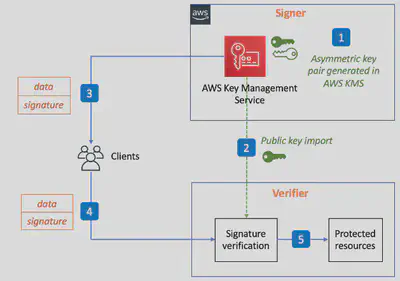
- During system setup, the
Signeris provisioned with anasymmetrickey pair. Signers such as AWS KMS support internal hardware security module (HSM)-backed, high-entropy asymmetric key generation and management. - The
Verifiersare configured to trust theSignerthrough an offline import of the Signer’spublic key. - During runtime, AWS KMS is requested to hash and create a digital signature over some original data. AWS KMS hashes the provided data and uses the
private keyin the asymmetric key pair to compute the signature over the hash. The original data, along with its signature, is delivered to a client. - The client forwards the data and signature to one or more
Verifiers, and requests access to their protected resources. - The
Verifiersverify the signature that is associated with the original data. The Verifiers use the Signer’spublic keyin this process. If the verification succeeds, meaning that the original data that was conveyed is unaltered and authentic, theVerifiersgrant the client access to their protected resources.
🌍Multi-Region Keys
A set of identical KMS keys in different AWS Regions that can be used interchangeably (~ same KMS key in multiple Regions)
Encrypt in one Region and decrypt in other Regions (No need to re-encrypt or making cross-Region API calls)
Multi-Regionkeys have the sameKey ID, key material, automatic rotation, …KMS Multi-Region are NOT global (Primary + Replicas)
Each Multi-Region key is managed independently
Only one primary key at a time, can promote replicas into their own primary
🧠Use cases: Disaster Recovery, Global Data Management (e.g., DynamoDB Global Tables), Active-Active Applications that span multiple Regions, Distributed Signing applications
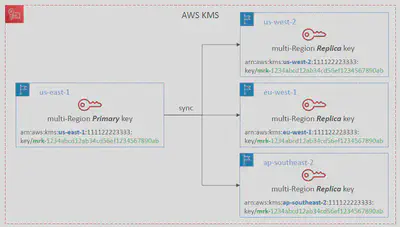
📥KMS Key Source - External (BYOK)
- Import your own key material into KMS key, Bring Your Own Key (
BYOK) - You’re responsible for key material’s security, availability, and durability outside of AWS
- Supports only
SymmetricKMS keys - Manually rotate your KMS key (Automatic & On-demand Key Rotation are NOT supported)
- Import your own key material into KMS key, Bring Your Own Key (
- AWS KMS enforces strict controls to ensure private keys remain secure and non-exportable.
- Allowing
Asymmetrickey import would break the trust model where KMS guarantees the private key never leaves its boundary.

🧰CloudHSM
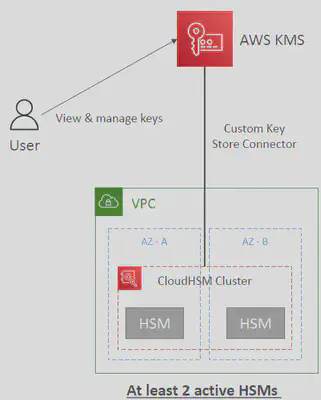
- CloudHSM => AWS provisions encryption hardware
- Dedicated Hardware (HSM = Hardware Security Module)
- You manage your own encryption keys entirely (not AWS)
- HSM device is tamper resistant, FIPS 140-2 Level 3 compliance
- Supports both
symmetricandasymmetricencryption (SSL/TLS keys) - No free tier available
- Must use the CloudHSM Client Software
- Redshift supports CloudHSM for database encryption and key management
- Good option to use with SSE-C encryption
📨Envelope Encryption
- KMS
Encrypt APIandDecrypt APIcalls have a limit of 4KB - If you want to encrypt >4 KB, we need to use
Envelope EncryptionusingData Keys - Data Keys are generated from CMKs. There is a direct relationship between Data Key and a CMK. However, AWS does NOT store or manage Data Keys. Instead, you have to manage them.
- The main API that will help us is the
GenerateDataKeyAPI - You can use one Customer Managed Key (
CMK) to generate thousands of unique data keys. You can generate data keys from a CMK using two methods:- Generate both Plaintext Data Key and Encrypted Data Key (
GenerateDataKey) - Generate only the Encrypted Data Key (
GenerateDataKeyWithoutPlaintext)
- Generate both Plaintext Data Key and Encrypted Data Key (
- After encryption, never keep the Plaintext data key together with Encrypted data(Ciphertext) since anyone can decrypt the Ciphertext using the Plaintext key. So remove the Plaintext data key from the memory as soon as possible. You can keep the Encrypted data key with the Ciphertext.
- The method of encrypting the key using another key is called
Envelope Encryption. By encrypting the key, that is used to encrypt data, you will protect both data and the key. - The whole purpose of this
Envelope encryptiontechnique is to use KMS for what it’s good at, which is to generate keys, and then the whole encryption and decryption happens at the client side.
sequenceDiagram participant App participant KMS App->>KMS: GenerateDataKey KMS-->>App: Plaintext Key + Encrypted Key App->>App: Encrypt data with Plaintext Key App->>App: Discard Plaintext Key App->>Storage: Store Encrypted Data + Encrypted Key- Client invokes the
GenerateDataKeyAPI into KMS. - Client gets the Plaintext data key and Encrypted data key from KMS, use the Plaintext data key to encrypt your large data on the client side.
- Discard the Plaintext data key and store the Encrypted data key together with the Encrypted data together as an “Envelope”

- When you want to decrypt it, call the KMS
DecryptAPI with the encrypted data key (🤔4KB limit). - KMS will send you the Plaintext key if you are authorized to receive it.
- Afterward, you can decrypt the Ciphertext using the Plaintext key on the client side again.
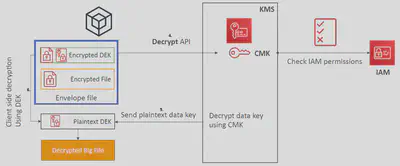
- KMS
Encryption SDK
The AWS Encryption SDK implemented Envelope Encryption for us
The Encryption SDK also exists as a CLI tool we can install
Implementations for Java, Python, C, JavaScript
Feature - Data Key Caching:
- Re-use data keys instead of creating new ones for each encryption
- Helps with reducing the number of calls to KMS with a security trade-off
- Use
LocalCryptoMaterialsCache(max age, max bytes, max number of messages)
KMS Key Policies
One of the powerful features in KMS is the ability to define permission separately for those who use the keys and administrate the keys. This is achieved using Key Policies (it’s a
Resource BasedPolicy). You can control access to KMS keys, similar to S3 bucket policies.Default KMS Key Policy:
Created if you don’t provide a specific KMS Key Policy
Complete access to the key to the
rootuser = entire AWS accountGives access to the IAM policies to the KMS key
The below Key Policy (Default) is applied to the
rootuser of the account. It allows full access to the CMK for any user in the account.{ "Sid": "Enable IAM User Permissions", "Effect": "Allow", "Principal": {"AWS": "arn:aws:iam::111122223333:root"}, "Action": "kms:*", "Resource": "*" }
Custom KMS Key Policy:
Define users, roles that can access the KMS key
Define who can administer the key
Useful for cross-account access of your KMS key
If you choose to distinguish users and roles who can manage key usage and key administration then we could achieve as follows:
The below IAM policy is applied to the IAM user
KeyUser. Now he has permission to use the CMK for encryption and decryption. However, he is not allowed to administrate that CMK.{ "Sid": "Allow use of the key", "Effect": "Allow", "Principal": {"AWS": "arn:aws:iam::111122223333:user/KeyUser"}, "Action": [ "kms:Decrypt", "kms:DescribeKey", "kms:Encrypt", "kms:GenerateDataKey*", "kms:ReEncrypt*" ], "Resource": "*" }The below IAM policy allows administrators (
KeyManager) to administrate the CMK that it is applied to. However, the administrator cannot use the key to Encrypt or Decrypt data.{ "Sid": "Allow access for Key Administrators", "Effect": "Allow", "Principal": {"AWS": [ "arn:aws:iam::111122223333:user/KeyManager" ]}, "Action": [ "kms:Create*", "kms:Describe*", "kms:Enable*", "kms:List*", "kms:Put*", "kms:Update*", "kms:Revoke*", "kms:Disable*", "kms:Get*", "kms:Delete*", "kms:TagResource", "kms:UntagResource", "kms:ScheduleKeyDeletion", "kms:CancelKeyDeletion" ], "Resource": "*" }
Cross-Account Key Policy
KMS keys are generally scoped per Region. That means if you have to copy a KMS encrypted EBS Volume across region:
🚫 Default AWS Keys can’t Be Used: Cross-region or cross-account snapshot copies require customer-managed CMKs — AWS-managed keys (
aws/ebsetc.) are not eligible because you cannot leverage a customKey Policy🔄 Shared CMK (
Trusted Zone): If both accounts are within a trusted boundary, you can share the source CMK via Key Policy. The target account can copy the snapshot using the same CMK ARN. For Shared CMK, the sourceKey Policymust explicitly allow cross-account access (kms:Decrypt,kms:ReEncrypt, etc.)📜 Key Policy & IAM Setup:
{
"Version": "2012-10-17",
"Id": "CrossAccountAccessKeyPolicy",
"Statement": [
{
"Sid": "AllowRootAccountAFullAccess",
"Effect": "Allow",
"Principal": {
"AWS": "arn:aws:iam::ACCOUNT_A_ID:root"
},
"Action": "kms:*",
"Resource": "*"
},
{
"Sid": "AllowAccountBViaEC2",
"Effect": "Allow",
"Principal": {
"AWS": "arn:aws:iam::ACCOUNT_B_ID:root"
},
"Action": [
"kms:Decrypt",
"kms:ReEncrypt*",
"kms:CreateGrant",
"kms:DescribeKey"
],
"Resource": "*",
"Condition": {
"StringEquals": {
"kms:ViaService": "ec2.us-west-2.amazonaws.com",
"kms:CallerAccount": "ACCOUNT_B_ID"
},
"Bool": {
"kms:GrantIsForAWSResource": "true"
}
}
}
]
}
- 🔐 Isolated CMK (
Untrusted Zone): If CMK sharing isn’t allowed, the target account must copy the snapshot using its own CMK. AWS securely decrypts and re-encrypts the data during transfer. For Isolated CMK, the target accountIAM Rolemust allowec2:CopySnapshotandkms:Encryptusing the target CMK.
{
"Version": "2012-10-17",
"Statement": [
{
"Sid": "CopySharedSnapshot",
"Effect": "Allow",
"Action": [
"ec2:CopySnapshot",
"ec2:DescribeSnapshots"
],
"Resource": "*"
},
{
"Sid": "UseTargetCMKForEncryption",
"Effect": "Allow",
"Action": [
"kms:Encrypt",
"kms:GenerateDataKey*",
"kms:DescribeKey"
],
"Resource": "arn:aws:kms:us-west-2:TARGET_ACCOUNT_ID:key/TARGET_KEY_ID"
}
]
}
KMS Request Quotas
When you exceed a request quota, you get a ThrottlingException:
- To respond, use exponential🌀 backoff (backoff and retry)
- For cryptographic operations, they share a quota. This includes requests made by AWS on your behalf (ex: SSE-KMS)
- For
GenerateDataKey, consider using DEK caching from the Encryption SDK - You can request a Request Quotas increase through API or AWS support
| API operation | Request quotas (per second) |
|---|---|
| Decrypt Encrypt GenerateDataKey (symmetric) GenerateDataKeyWithoutPlaintext (symmetric) GenerateRandom ReEncrypt Sign (asymmetric) Verify (asymmetric) | These shared quotas vary with the AWS Region and the type of CMK used in the request. Each quota is calculated separately. Symmetric CMK quota: * 5,500 (shared) * 10,000 (shared) in the following Regions: * us-east-2, ap-southeast-1, ap-southeast-2, ap-northeast-1, eu-central-1, eu-west-2 * 30,000 (shared) in the following Regions: * us-east-1, us-west-2, eu-west-1 Asymmetric CMK quota: * 500 (shared) for RSA CMKs * 300 (shared) for Elliptic curve (ECC) CMKs |
S3 Encryption for Objects
There are several methods of encrypting objects in S3 at rest
SSE-S3: encrypts S3 objects using keys handled & managed by AWS - AWS Owned KeysSSE-KMS: leverage AWS Key Management Service to manage encryption keys - AWS Managed KeysSSE-C: when you want to manage your own encryption keys - key not stored inKMS. CloudHSM could be usedClient SideEncryption - key not stored inKMSGlacier: all data is AES-256 encrypted, key under AWS control
Encryption in transit (
SSL/TLS)- Every S3 bucket and object is accessible via:
- These endpoints are globally available and automatically provisioned by AWS.
- You’re free to use the endpoint you want, but HTTPS is recommended
- HTTPS is mandatory for
SSE-C - To enforce HTTPS, use a Bucket Policy with a
ws:SecureTransport
{ "Version": "2012-10-17", "Statement": [ { "Sid": "AllowSSLRequestsOnly", "Effect": "Deny", "Principal": "*", "Action": "s3:*", "Resource": [ "arn:aws:s3:::your-bucket-name", "arn:aws:s3:::your-bucket-name/*" ], "Condition": { "Bool": { "aws:SecureTransport": "false" } } } ] }SSE-KMS
SSE-KMSencryption is using keys handled & managed by KMSObject is encrypted server side
Must set header:
x-amz-server-side-encryption: ”aws:kms"SSE-KMS leverages the
GenerateDataKey&DecryptKMS API callsEven if S3 bucket/objects were made public, if it’s encrypted with
SSE-KMS, they can never be read. Because a public anonymous user will never have access toKMS key.These KMS API calls will show up in CloudTrail, helpful for logging
To perform SSE-KMS, you need:
- A KMS
Key Policythat authorizes the user / role - An
IAM policythat authorizes access to KMS, otherwise you will get anAccess Deniederror - Security Policy for enforcing encryption via SSE-KMS:
{ "Version": "2012-10-17", "Statement": [ { "Effect": "Deny", "Principal": "*", "Action": "s3:PutObject", "Resource": "arn:aws:s3:::$BucketName/*", "Condition": { "StringNotEqualsIfExists": { "s3:x-amz-server-side-encryption": "aws:kms" }, "Null": { "s3:x-amz-server-side-encryption": "false" } } }, { "Effect": "Deny", "Principal": "*", "Action": "s3:PutObject", "Resource": "arn:aws:s3:::$BucketName/*", "Condition": { "StringNotEqualsIfExists": { "s3:x-amz-server-side-encryption-aws-kms-key-id": "arn:aws:kms:$Region:$AccountId:key/$KeyId" } } } ] }
- A KMS
KMS Pros: User control + Audit trail via
CloudTrailKMS Cons: Each object upload typically triggers a
GenerateDataKeyAPI call to KMS, which incurs cost, latency and is rate-limited.- If throttling, try exponential backoff or you can request an increase in KMS limits
- The service throttling is KMS, not Amazon S3

S3 Bucket Keyfor SSE-KMS: To circumvent these limitations AWS has introduced aS3 Bucket Keywhich is a bucket-level data key that Amazon S3 uses to reduce the number of direct calls to AWS KMS.Auditability — fewer KMS calls means fewer CloudTrail entries, but you still get visibility into the initial key generation.
How it works:
- When enabled, KMS issues a bucket-level key (encrypted under your CMK) for the same
GenerateDataKeyAPI call - S3 caches this bucket key internally for a limited time.
- For subsequent object uploads, S3 uses this cached bucket key to generate per-object data keys, without calling KMS again.
- The object is encrypted using the derived data key, and the metadata includes the encrypted bucket key.
- When enabled, KMS issues a bucket-level key (encrypted under your CMK) for the same
🗪 Layer 5: Session
The session layer manages the creation, maintenance, and termination of communication sessions between systems. In modern applications, these sessions often involve authenticated users, federated identities, or temporary roles. At this layer, threats like session hijacking, token replay, or unauthorized impersonation can compromise the integrity of secure interactions.
AWS Cognito
AWS STS
Amazon API Gateway
IAM Identity Center
🚦Layer 4: Transport
The transport layer governs how data is transmitted between systems over protocols such as TCP and UDP. At this level, attackers often attempt to exploit open ports, overwhelm systems with malformed packets or connection floods, or entirely disrupt communication channels. Protecting this layer means controlling access to specific ports, managing protocol behavior, and filtering out malicious traffic early in the request flow.
🛡️AWS Shield
AWS Shield provides automated, scalable, and cost-protected DDoS defense across network and application layers.
- AWS
ShieldStandard:- Free service that is activated for every AWS customer
- Provides protection from attacks such as SYN/UDP Floods, Reflection attacks and other
Layer-3/Layer-4attacks
- AWS
Shield Advanced:- Optional DDoS mitigation service ($3,000💰 per month per organization)
- Protect against more sophisticated attack on Amazon EC2, Elastic Load Balancing (ELB), Amazon CloudFront, AWS Global Accelerator, Route 53
- 24/7 access to AWS DDoS response team (DRP)
- Protect against higher fees during usage spikes due to DDoS
🧑💻AWS Firewall Manager
Manage rules in all accounts of an AWS Organization
Security policy: common set of security rules
WAF rules (Application Load Balancer, API Gateways, CloudFront)
AWS Shield Advanced (ALB, CLB, NLB, Elastic IP, CloudFront)
Security Groups for EC2, Application Load Balancer and ENI resources in VPC
AWS Network Firewall (VPC Level)
Amazon Route 53 Resolver DNS Firewall
Policies are created at the region level
Rules are applied to new resources as they are created (good for compliance) across all and future accounts in your Organization
WAF,ShieldandFirewall Managerare used together for comprehensive protectionDefine your Web ACL rules in
WAFFor granular protection of your resources,
WAFalone is the correct choiceIf you want to use AWS WAF across accounts, accelerate WAF configuration, automate the protection of new resources, use
Firewall Managerwith AWSWAFShield Advancedadds additional features on top of AWS WAF, such as dedicated support from the Shield Response Team (SRT) and advanced reporting.If you’re prone to frequent DDoS attacks, consider purchasing Shield Advanced
🌐Layer 3: Network
The network layer controls how data is routed between systems using IP addressing. It plays a central role in cloud security architecture, as it’s often the first line of defense against external threats. At this layer, attackers may attempt IP spoofing, network scanning, or distributed denial-of-service (DDoS) attacks to overwhelm resources or probe for vulnerable endpoints.
Amazon Virtual Private Cloud (VPC)
Network ACLs (NACL)
Route Tables
Internet Gateways
NAT Gateways
Route 53
🔢Layer 2: Data Link
The Data Link Layer handles node-to-node communication using Ethernet frames, MAC addresses, and VLANs. In AWS, traditional Layer-2 risks like MAC spoofing, ARP poisoning, and VLAN hopping are mitigated because Layer-2 is fully abstracted from customers. Amazon VPC is designed to isolate network traffic at the virtualization layer, eliminating direct exposure to MAC addresses or switching infrastructure.
Key AWS Controls:
- No raw
Layer 2exposure: Customers cannot send Ethernet frames directly. - VPC Isolation: Logical isolation prevents cross-tenant traffic.
- Managed ARP & No Broadcast Domains: Eliminates ARP spoofing and floods.
Security Groups&NACLs: Enforce traffic filtering at higher layers.
Direct Connect & Layer 2:
- Provides dedicated physical connectivity using Ethernet (
Layer-2). - Supports 802.1Q VLAN tagging and Link Aggregation (LAG).
- AWS enforces port-level security and MAC filtering at Direct Connect locations. vant Resources
🏢Layer 1: Physical
The physical layer secures the most basic infrastructure — cabling, power, servers, and data center access. In AWS, this responsibility shifts from customers to AWS, which owns and operates global facilities.
Threats include hardware tampering, rogue devices, signal interception, theft of media, and environmental risks like power loss or overheating. These bypass software defenses, making physical security the first line of protection.
AWS prevents customer access and enforces strict controls validated by compliance reports via AWS Artifact (SOC 2, ISO 27001, PCI DSS).
While customers don’t manage hardware, monitoring tools like AWS CloudTrail and AWS Config help detect anomalies in workloads.